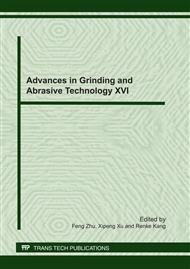p.391
p.396
p.402
p.407
p.413
p.419
p.423
p.429
p.433
Influence of Ultrasonic Assistance on Material Removal Mechanism of Hard and Brittle Materials Based on Single-Point Scratch
Abstract:
In order to deeply study the influence of ultrasonic assistance on material removal characteristics of hard and brittle materials, a series of ultrasonic assisted single-point scratch experiments have been carried out in this paper. Experimental results show that the assisted ultrasonic vibration is benefit to increase the critical cutting depth and enlarge the ductile regime of material removal. The main reason can be explained as the influences of blank cutting phenomenon, the decrease of the normal cutting force under the same depth of cut, the decrease of the material hardness under ultrasonic excitation and the shielding effect of lateral crack.
Info:
Periodical:
Pages:
413-418
Citation:
Online since:
July 2011
Price:
Сopyright:
© 2011 Trans Tech Publications Ltd. All Rights Reserved
Share:
Citation:


